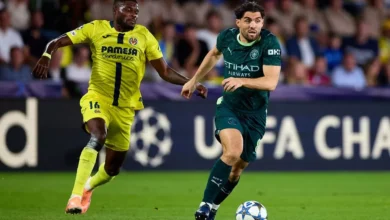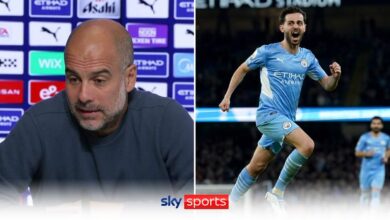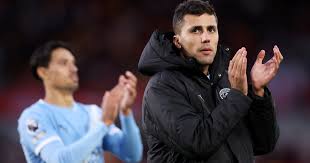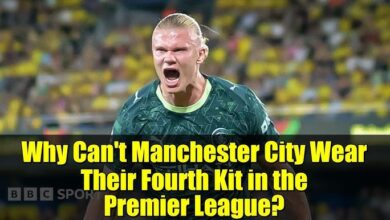Phil Foden’s Tactical Evolution: Manchester City’s Midfielder Emerges from Shadow of Struggle to Shine in Transformed Role During Everton Victory
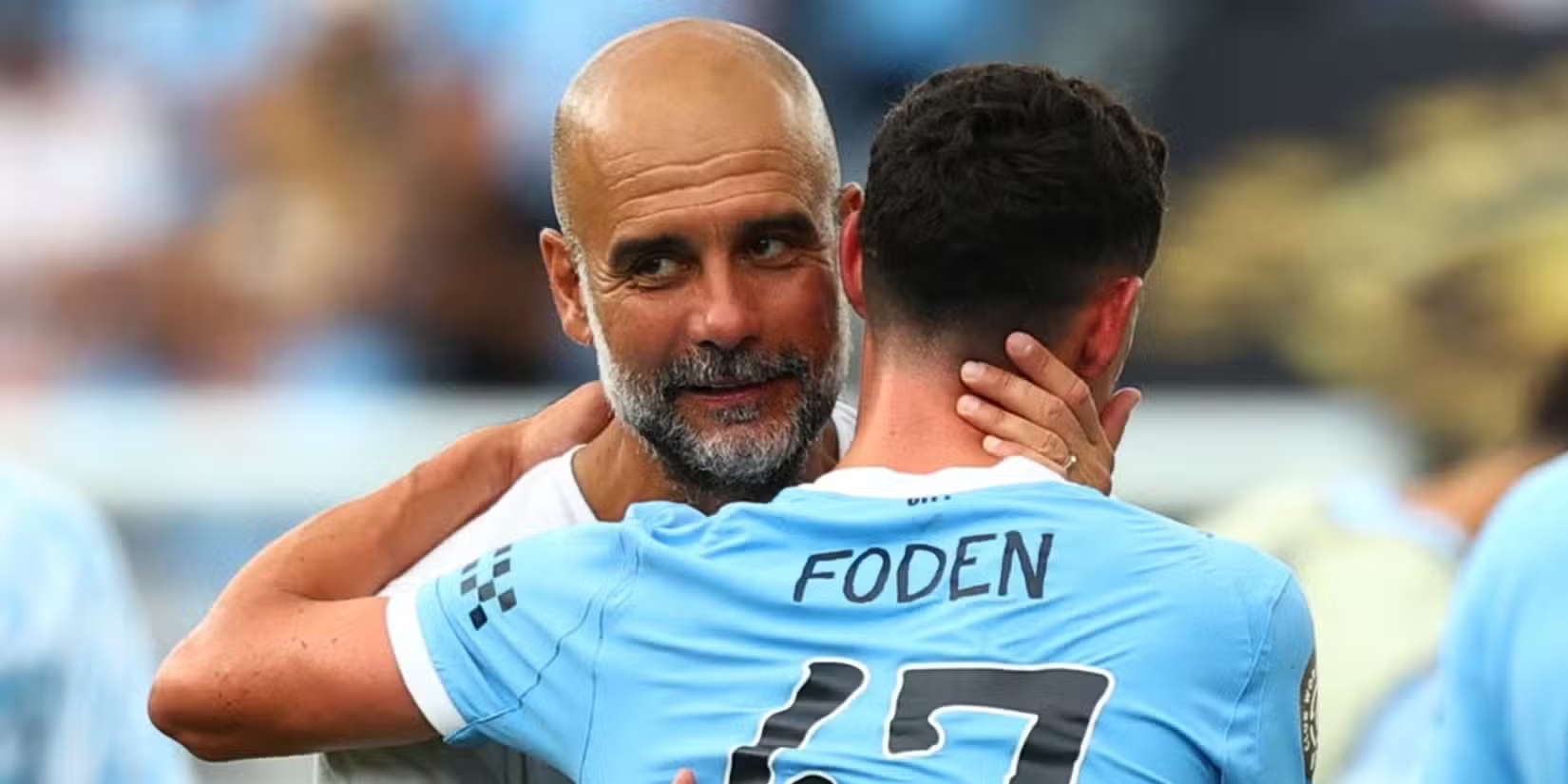
Manchester City’s relentless march toward reclaiming domestic supremacy continued unabated on Saturday afternoon as Pep Guardiola’s side dispatched Everton 2-0 at the Etihad Stadium, extending their unbeaten run across all competitions to an impressive eight matches. While Erling Haaland’s clinical brace predictably dominated post-match discussions—the Norwegian striker’s seemingly inexhaustible capacity for finding the net showing no signs of diminishing—it was another star’s performance, one operating in an unfamiliar position, that truly captured the imagination of City supporters and tactical observers alike.
Phil Foden, Manchester City’s homegrown prodigy and reigning Player of the Season from the 2023/24 campaign, delivered a midfield masterclass that showcased both his technical brilliance and his growing tactical maturity. Deployed in a deeper midfield role—a position necessitated by Kevin De Bruyne’s summer departure to Napoli—Foden orchestrated City’s attacking play with the kind of subtle genius that characterized David Silva’s legendary tenure at the club. His performance offered compelling evidence that City may have found the solution to their most pressing creative conundrum, while simultaneously suggesting that Foden himself is emerging from a prolonged period of inconsistent form that has shadowed his recent performances.
The Context: City’s Creative Void and Foden’s Struggles
To fully appreciate the significance of Foden’s performance against Everton, one must understand the context surrounding both Manchester City’s current circumstances and the player’s own recent trajectory. The summer departure of Kevin De Bruyne to Napoli represented far more than simply losing a world-class player—it removed the creative heartbeat that had powered City’s attacking machinery for nearly a decade. De Bruyne’s ability to unlock defenses with visionary passing, his capacity to control match tempo, and his leadership qualities left a void that many questioned whether any single player could adequately fill.
Pep Guardiola, never one to be constrained by conventional thinking, identified Foden as the natural heir to De Bruyne’s creative throne. The logic was sound: Foden possesses exceptional technical quality, has developed under Guardiola’s tutelage since his teenage years, understands City’s tactical principles instinctively, and has demonstrated his quality across multiple positions. However, the transition from wide attacking player to central creative fulcrum represents a significant tactical evolution that requires both time and adaptation.
Complicating matters further, Foden has endured an extended period of inconsistent form that has seen him struggle to replicate the devastating effectiveness that characterized his Player of the Season campaign. The weight of expectation following that individual triumph, combined with the additional creative responsibility thrust upon him by De Bruyne’s departure, appeared to burden rather than inspire the Englishman. His performances, while never poor, lacked the dynamism and decisiveness that separate good displays from match-winning contributions.
Match after match, Foden showed flashes of his considerable ability—a clever pass here, a dangerous dribble there—but the complete performance that demonstrated his capacity to shoulder City’s creative burden remained frustratingly elusive. Questions began circulating among supporters and pundits alike: Was Foden struggling under the pressure of heightened expectations? Did his game lack the tactical discipline required for deeper midfield positions? Could he truly replace De Bruyne’s irreplaceable influence?
Saturday’s performance against Everton provided emphatic answers to these questions.
First Half: Iliman Ndiaye’s Messi Moments and City’s Measured Response
The opening period developed into a fascinating tactical chess match that defied many pre-match predictions. Everton, arriving at the Etihad as significant underdogs, refused to simply park the proverbial bus and accept defensive absorption. Instead, Sean Dyche’s side showed genuine ambition in possession, attempting to exploit spaces in City’s defensive structure through quick transitions and the individual brilliance of Iliman Ndiaye.
The Everton attacking midfielder produced a first-half performance that had observers reaching for their most exalted comparisons. Ndiaye’s spellbinding solo runs, characterized by close control, explosive acceleration, and the kind of balance that allows players to glide past challenges, drew inevitable comparisons to Lionel Messi—high praise indeed, even allowing for the hyperbole that often accompanies impressive individual displays. His mazy dribbles through City’s midfield threatened to unlock Guardiola’s defense on multiple occasions, providing Everton with their most potent attacking weapon.
However, while Ndiaye’s individual artistry captured attention, it was City’s collective control—orchestrated largely by Foden operating in his deeper midfield position—that ultimately proved more substantive. Where Ndiaye represented style, City embodied substance. Foden’s positioning and movement during this period demonstrated his growing understanding of the role’s tactical requirements.
Operating in the left-sided number eight position, Foden constantly offered passing options to his defensive colleagues, helping City progress the ball through Everton’s pressing structure. His awareness of space was exemplary, repeatedly finding pockets between Everton’s defensive and midfield lines where he could receive possession in dangerous areas. More impressively, Foden demonstrated the discipline to fulfill his defensive responsibilities, tracking runners and maintaining his position within City’s structure even when his attacking instincts might have encouraged more adventurous positioning.
The statistics from the opening period illustrated Foden’s growing comfort in this deeper role. His passing accuracy remained characteristically high, while his positioning enabled City to maintain territorial dominance despite Everton’s periodic threatening moments. Unlike some creative players who struggle with the defensive aspects of central midfield play, Foden showed genuine commitment to winning possession back, engaging in duels and pressing intelligently to disrupt Everton’s attempts to build attacks.
Yet the breakthrough remained elusive as the teams headed toward halftime. City’s dominance in possession and territorial control had not translated into clear goalscoring opportunities, while Everton’s defensive organization and Ndiaye’s individual brilliance kept the contest finely balanced. Guardiola’s halftime message would prove crucial in transforming City’s control into tangible advantage.
Second Half Transformation: Foden’s Orchestration and Haaland’s Clinical Finishing
Whatever tactical adjustments Guardiola implemented during the interval proved immediately effective. City emerged for the second period with renewed purpose and intensity, their passing sharper, their movement more purposeful, and their attacking patterns more varied. At the heart of this transformation stood Phil Foden, whose influence on proceedings grew exponentially as Everton’s resistance began to waver.
Foden’s involvement in both of Manchester City’s goals, while not resulting in ‘direct’ statistical contributions like assists, perfectly illustrated the subtle yet crucial role he was fulfilling. Modern football’s obsession with quantifiable metrics—goals, assists, key passes—often overlooks the kind of intelligent off-ball movement and pre-assist contributions that make goalscoring opportunities possible. Foden’s performance provided a masterclass in this often-underappreciated aspect of creative midfield play.
For Haaland’s opening goal in the 59th minute, Foden’s contribution came through his positioning and movement, which dragged Everton’s midfielders out of position and created the space for Nico O’Reilly to deliver his decisive cross. Foden’s run toward the ball drew two Everton players, opening passing lanes that O’Reilly exploited brilliantly. When the cross arrived, Haaland applied his clinical finish, but the goal’s genesis could be traced to Foden’s intelligent movement and spatial awareness.
The second goal, arriving just four minutes later, again bore Foden’s fingerprints despite Savinho receiving credit for the assist. Foden’s pass to Savinho, while not the final ball, was delivered with perfect weight and timing, putting the Brazilian in position to tee up Haaland’s second. More significantly, Foden’s earlier movement had destabilized Everton’s defensive shape, creating the disorganization that Savinho exploited with his through ball.
These contributions—the runs that create space, the passes before the assist, the movements that disrupt defensive structures—represent the kind of sophisticated offensive play that separates good creative midfielders from truly elite ones. David Silva built his legendary Manchester City career on precisely this type of subtle yet devastating influence, and Foden’s display against Everton suggested he is beginning to master these same arts.
The Statistical Story: Numbers That Tell a Compelling Narrative
While Foden’s influence transcended mere statistics, the numbers from his 90-minute performance provide compelling evidence of his growing mastery of this deeper midfield role. His pass completion rate of 94 percent demonstrated both his technical security and his intelligent decision-making—consistently finding teammates while rarely surrendering possession through ambitious but low-percentage passes.
Perhaps more impressively, Foden created four key passes during the match—passes that lead directly to shooting opportunities—showcasing his ability to unlock defenses even from deeper positions. One of these key passes was classified as a ‘big chance created,’ the kind of gilt-edged opportunity that teammates should reasonably be expected to convert. This creative output from a deeper midfield position represents exactly the kind of production City require to compensate for De Bruyne’s departure.
Foden’s own shooting effort, which struck the woodwork, demonstrated his willingness to add personal goalscoring threat to his creative contributions. The ability to arrive in dangerous positions from midfield and produce quality finishing represents an additional dimension that makes him even more difficult for opponents to contain. Defenders who focus exclusively on preventing his creative passes leave themselves vulnerable to his late runs into the penalty area.
His dribbling statistics proved equally impressive. Foden attempted three dribbles during the match and successfully completed all three—a 100 percent success rate that illustrated both his technical quality and his intelligent selection of moments to take on opponents directly. Rather than dribbling for dribbling’s sake, Foden chose his moments carefully, using his close control and acceleration to escape pressure situations or advance into dangerous areas when passing options were unavailable.
Perhaps most surprising were Foden’s defensive contributions, which demonstrated his commitment to the complete midfield role rather than simply focusing on attacking responsibilities. He won two tackles during the match and succeeded in six of his nine ground duels—a 67 percent success rate that many defensively-minded midfielders would be pleased with, let alone an attack-minded creative player adjusting to new positional responsibilities.
These numbers paint a picture of a player who is not merely occupying a new position but genuinely excelling in it. Foden demonstrated technical security (94 percent pass completion), creative threat (four key passes including one big chance created), dribbling quality (three successful dribbles from three attempts), and defensive contribution (two tackles won, six ground duels won). This represents the complete midfield performance that Guardiola demands from players operating in these crucial positions.
Social Media Reaction: Recognition of Foden’s Tactical Evolution
The performance did not go unnoticed among Manchester City supporters and neutral observers, with social media platforms buzzing with recognition of Foden’s tactical evolution. The reactions ranged from statistical appreciation to broader tactical analysis, but a common theme emerged: Foden is successfully navigating the transition from wide attacking player to central creative midfielder.
One particularly astute X (formerly Twitter) user captured the essence of Foden’s contribution perfectly: “Foden’s involvement brilliant in both goals albeit without a ‘direct’ goal involvement. He has been so impressive this season, making things tick for City in a slightly more subtle way. Deserves huge credit.”
This observation highlighted precisely what makes Foden’s current performances so significant. In an era obsessed with individual statistical contributions—who got the assist, who created the chance, who made the key pass—Foden is demonstrating that influence can manifest in subtler yet equally important ways. His movements, his positioning, his pre-assist passes, and his general orchestration of City’s attacking play represent the kind of sophisticated contributions that statistics often fail to capture but that trained eyes immediately recognize.
Another supporter drew explicit comparisons to David Silva, writing: “This Foden David Silva impression has been insane today.” The comparison is particularly apt and represents perhaps the highest compliment a City midfielder can receive. Silva’s decade-long spell at Manchester City established him as arguably the club’s greatest-ever player, with his ability to control matches through subtle genius rather than spectacular individualism setting the standard for City’s midfield play.
That Foden is now drawing comparisons to Silva suggests he is successfully capturing the essence of that role—the intelligent positioning, the quick one-touch passing, the ability to find space in congested areas, and the general orchestration of attacking play that makes teammates better. If Foden can continue developing in this mold, City may not simply be replacing De Bruyne’s creativity but evolving their midfield play in a direction that proves equally effective while being stylistically different.
A third observer simply stated: “This new Phil Foden role is beautiful,” capturing the aesthetic pleasure of watching an exceptionally talented player discover a position that maximizes his abilities. Football at its highest level is as much art as sport, and watching a player of Foden’s quality operating in a role that showcases his complete skill set provides genuine pleasure beyond simply winning matches.
Another supporter focused on Foden’s specific contributions to City’s goals: “Foden, I’m saluting this performance. Made both of the goals.” While the statistical record won’t show Foden registering assists for either strike, this observer recognized that goals are rarely the product of a single pass or movement. They result from sequences of play, from collective actions that create the disorganization and space that clinical finishers exploit. Foden’s role in creating both goalscoring opportunities deserves recognition even if traditional statistics don’t capture it.
Perhaps the most tactically insightful observation came from a supporter who wrote: “So much changed when Foden moved into that number eight role.” This comment acknowledged not just Foden’s individual quality but the broader tactical implications of his positional evolution. City’s entire attacking structure functions differently with Foden operating as a deep-lying creator rather than a wide attacker, providing them with a different balance and different offensive options that could prove crucial as the season progresses.
Tactical Analysis: The Number Eight Role and Its Demands
To fully appreciate Foden’s performance, one must understand the specific demands of the number eight position in Pep Guardiola’s tactical system. This role represents one of the most demanding in modern football, requiring a unique combination of technical ability, tactical intelligence, physical capacity, and mental discipline that few players genuinely possess.
The number eight in Guardiola’s system must function as a connector between defense and attack, constantly offering passing options to defensive colleagues while positioning themselves to receive the ball in dangerous areas. They must possess the technical security to retain possession under pressure, the vision to spot attacking opportunities, and the passing ability to execute those opportunities with precision. Defensively, they must track runners, press intelligently, and maintain positional discipline within the team’s structure.
David Silva mastered this role during his Manchester City career, becoming the template against which subsequent occupants are measured. His ability to receive the ball in tight spaces, turn away from pressure, and deliver the killer pass that unlocked defenses became his signature contribution. Equally important, though less celebrated, was his tactical discipline—his positioning within City’s structure, his defensive work rate, and his general game management that helped City control matches.
Kevin De Bruyne evolved this role in his own image, adding greater physicality, more direct passing, and enhanced goalscoring threat while maintaining the core attributes Silva exemplified. His departure to Napoli left questions about who could inherit these responsibilities and whether anyone possessed the complete skill set required.
Foden’s performance against Everton demonstrated that he is rapidly developing the attributes necessary to excel in this demanding role. His technical quality was never in doubt—few players in world football can match his close control, quick feet, and precision passing. What Saturday’s display revealed was his growing tactical understanding of the position’s spatial requirements and his willingness to embrace the defensive responsibilities that the role demands.
His positioning throughout the match showed sophisticated awareness of where to be at different phases of play. In the defensive phase, he maintained his position within City’s structure, helping provide numerical superiority in midfield when Everton attempted to build attacks. In the transition phase, he quickly identified spaces to exploit, making himself available for passes that would advance City into dangerous positions. In the attacking phase, he took up intelligent positions between Everton’s defensive and midfield lines, creating dilemmas for opponents about who should track him.
This positional intelligence, combined with his technical excellence and growing physical maturity, suggests Foden possesses the complete package required to become an elite number eight. His performance against Everton may be remembered as the match where this tactical evolution truly crystallized, where he demonstrated definitively that he can shoulder the creative burden De Bruyne’s departure placed upon him.
Haaland’s Clinical Contribution: Substance Over Style
While Foden’s midfield mastery dominated much of the tactical discussion, Erling Haaland’s match-winning brace deserves appropriate recognition. The Norwegian striker’s two goals took his season tally to yet another impressive milestone, maintaining the extraordinary scoring rate that has characterized his entire Manchester City career.
Both finishes showcased Haaland’s complete striker’s repertoire. His opening goal demonstrated his movement and finishing quality, attacking the cross with perfect timing and directing his header precisely into the corner. The second goal highlighted his composure in one-on-one situations, calmly slotting past Jordan Pickford when many strikers might have snatched at the opportunity.
Yet Haaland’s contribution extended beyond his goals. His movement constantly stretched Everton’s defense, creating space for teammates to exploit. His physical presence occupied defenders, preventing them from stepping forward to press City’s midfielders. His work rate, often overlooked when discussing his attributes, disrupted Everton’s attempts to build from the back.
The match narrative captured this perfectly: while Iliman Ndiaye provided style with his mazy dribbles and individual artistry, Haaland and Manchester City delivered substance through their clinical efficiency and collective quality. Ndiaye’s highlights might populate social media compilations, but Haaland’s goals and City’s victory will occupy the record books—a perfect illustration of football’s eternal tension between aesthetic pleasure and cold effectiveness.
The Broader Context: City’s Title Challenge and Foden’s Crucial Role
This victory moved Manchester City back to the top of the Premier League table, continuing their pursuit of domestic supremacy following Liverpool’s championship triumph the previous season. The Citizens’ eight-match unbeaten run across all competitions demonstrates the kind of consistency required to sustain title challenges, while their ability to win even when not performing at maximum capacity—as evidenced by a somewhat disjointed first half against Everton—speaks to championship mentality.
For City to reclaim the title, Phil Foden’s continued excellence in his deeper midfield role may prove absolutely crucial. Kevin De Bruyne’s departure created a creative void that threatened to undermine City’s attacking potency, leaving them vulnerable to well-organized defenses that could neutralize their wide attackers. Foden’s successful transition to this creative midfield position provides City with the control and creativity needed to break down stubborn defensive blocks.
His form also impacts City in less obvious ways. Foden’s emergence as a genuine creator from deep positions allows Guardiola tactical flexibility to deploy other attackers in more advanced roles, knowing that creative responsibility is being shouldered effectively. It provides different passing angles and attacking patterns that make City less predictable and therefore more difficult to defend against. It adds another dimension to their play that complements rather than simply replicates what they lost with De Bruyne’s departure.
Moreover, Foden’s successful adaptation demonstrates something crucial about both the player and the club: their capacity to evolve, to adapt to changing circumstances, to develop solutions to new challenges. This adaptability, this refusal to be constrained by setbacks or forced into predictable patterns, represents a competitive advantage that extends beyond individual matches or even individual seasons.
Conclusion: A Performance That Signals Transformation
Manchester City’s 2-0 victory over Everton will be remembered primarily for extending their unbeaten run and returning them to the Premier League summit. Erling Haaland’s brace will dominate headline coverage and highlight packages. But for those paying closer attention, the match offered something potentially more significant: compelling evidence that Phil Foden is successfully navigating the transition from wide attacker to central creative midfielder.
His 90-minute masterclass demonstrated technical security (94 percent pass completion), creative threat (four key passes including one big chance created), dribbling quality (100 percent success rate), and defensive contribution that many attack-minded players would never provide. His involvement in both goals, while not resulting in statistical assists, perfectly illustrated the subtle yet crucial influence that defines elite creative midfielders.
The social media reaction captured this significance, with supporters recognizing that they were witnessing not just a good performance but the crystallization of a tactical evolution that could define Manchester City’s season. Comparisons to David Silva, recognition of his complete midfield display, and acknowledgment of how City’s entire attacking structure changes with Foden in this role all pointed to a player discovering his optimal position.
After an extended period of inconsistent form, after struggling to shoulder the creative burden thrust upon him by Kevin De Bruyne’s departure, Phil Foden appears to be emerging from the shadow of those struggles. His performance against Everton suggested that Manchester City may have found their creative solution, that Foden may have discovered his defining role, and that the 2023/24 Player of the Season is ready to reclaim that form when his team needs it most.
If Foden can maintain this level of performance—combining technical excellence with tactical intelligence, creative flair with defensive discipline, individual quality with collective responsibility—then Manchester City’s title challenge possesses the creative heartbeat required for sustained success. Saturday’s display against Everton may well be remembered as the afternoon when Phil Foden truly came of age as Manchester City’s orchestrator-in-chief, ready to lead their pursuit of glory from his new position in the heart of midfield.








